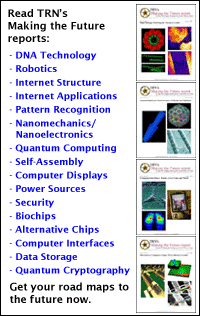
Self-assembly: the natural way
to make things
Natureís building block is the molecule, that collection of atoms that gives a material or substance its properties. And the molecule that serves as the blueprint for all of lifeís processes is deoxyribonucleic acid (DNA).
Life's plan
Biological DNA is made up of long strings of four types of bases - adenine, cytosine, guanine and thymine - attached to a sugar-phosphate backbone. Adenine pairs up with thymine and cytosine with guanine when two single strands of DNA mesh to form the familiar double helix.
DNA makes the proteins that carry out lifeís processes by exposing a portion of a single strand as a template; the requisite protein can assemble automatically simply by matching up base pairs. In a cell, this happens in a more complicated two-step process. DNA provides a template for ribonucleic acid (RNA), which then acts as a template for proteins outside the cellís nucleus.
DNAís replication process is a similar self-assembly process. When the strands separate, each single strand becomes a template for new pairs.
Researchers can make artificial strands of DNA that have specific sequences of base pairs designed so that the strands combine to form structures or produce specific proteins.
Connecting things up
Most of lifeís processes are carried out by protein molecules that fold into various shapes. Proteins recognize and connect to other molecules based on shapes, similar to a key fitting into a lock.
Once two molecules come together in a lock and key formation, there are several ways the two molecules can bond to each other without going so far as chemically fusing. The two that show promise for technological self-assembly are electrostatic interactions and hydrophobic interactions.
Ectrostatic interactions occur when the positive electrical charge of one atomís nucleus attracts the negative charge of anotherís electrons. Once the molecules get close enough, this charge draws the two together and holds them at the point where the two atomsí electrons begin to repel each other.
Hydrophobic interactions occur when molecules that are electrically balanced, or nonpolar, are repelled by polar molecules, notably water. The electric charges in polar molecules are asymmetrical. Polar molecules attract each other, which has the effect of rounding up any interspersed nonpolar molecules.
Building a bigger molecule
One way to make large molecules is to use smaller molecules as building blocks. Polymerization, or the process of forming large molecules, polymers, from small molecules, or monomers, occurs throughout nature.
There are two basic types of polymerization reactions: chain reactions, and step reactions.
Step reactions, also known as condensation polymerization, are relatively slow and result in relatively simple polymers. This process forms natural polymers like silk and artificial polymers like many household plastics, but itís slow pace makes it less useful than chain reactions for self-assembly.
Chain reactions
In contrast, chain reaction polymerization is very fast. It also often results in branched molecules and cross-linking between polymer strands, which are useful for shaping nanostructures and mating polymers with nanoparticles or other molecules.
Chain reaction polymerization forms polymers from small molecules that contain two carbon atoms with two shared pairs of electrons. If one of the bonds between the two carbon atoms is broken, the molecule becomes a free radical, which is very reactive. When two free radicals meet, their unpaired electrons form a new covalent bond, creating a single, larger molecule. Hundreds or thousands of molecules can link this way to form long polymers.
Advertisements:
Stories:
Nanowire networks route light
Cell combo yields blood vessels
Physics maps city complexity
How It Works: Self-assembly
Briefs:
Paint program renders ink physics
Silicon light switch is electric
Crystal promises more light
Micro marbles make nano rings
News:
Research News Roundup
Research Watch blog
Features:
View from the High Ground Q&A
How It Works
RSS Feeds:
News
Ad links:
Buy an ad link
| Advertisements:
|
 |
Ad links: Clear History
Buy an ad link
|
TRN
Newswire and Headline Feeds for Web sites
|
© Copyright Technology Research News, LLC 2000-2006. All rights reserved.